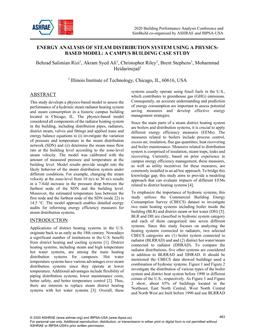
Energy Analysis of Steam Distribution System Using a Physics-Based Model: A Campus Building Case Study
- Comments Off on Energy Analysis of Steam Distribution System Using a Physics-Based Model: A Campus Building Case Study
- ASHRAE
Click here to purchase
This study develops a physics-based model to assess the performance of a hydronic steam radiator heating system and steam consumption in a historic campus building located in Chicago, IL. The physics-based model considered all components of the radiator heating system in the building, including distribution pipes, radiators, district steam, valves and fittings and applied mass and energy balance equations to (i) investigate the variation of pressure and temperature in the steam distribution network (SDN) and (ii) determine the steam mass flow rate at the building level according to the zone-level steam velocity. The model was calibrated with the amount of measured pressure and temperature at the building level. Model results provide insight into the likely behavior of the steam distribution system under different conditions. For example, changing the steam velocity at the zone-level from 10 m/s to 30 m/s results in a 7-fold increase in the pressure drop between the furthest node of the SDN and the building level. Moreover, the estimated temperature loss between the first node and the furthest node of the SDN (node 22) is 14.5 °C. The model approach enables detailed energy audits for informing energy efficiency measures for steam distribution systems.
Citation: ASHRAE/IBPSA-USA Bldg Simulation Conf, Sept 2020
Product Details
- Published:
- 2020
- File Size:
- 1 file , 900 KB
- Product Code(s):
- D-BSC20-C056

